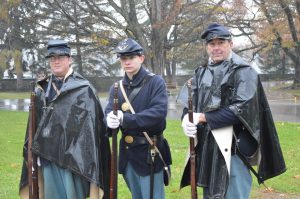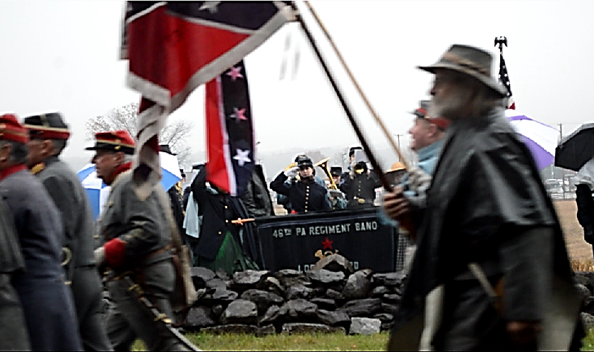Remembrance Day Honors History, Avoids Credible Threat
Gettysburg — Hot and humid may best describe the summer weather faced by opposing soldiers at the Battle of Gettysburg. That early July heat was a far cry from the frigid rain their descendants brooked in this rural town last Saturday. But nothing – including heightened security and what law enforcement termed a “credible threat” – was going to stop the thousands who made their way to Gettysburg for Remembrance Day.
An annual event, Remembrance Day includes wreath ceremonies, history presentations, a parade and several Civil War Balls. The festivities are designed to honor the brave men on both sides of the conflict who fell while serving their states on the field of battle.
Remembrance Day also marks Gettysburg’s Memorial Day celebration, recalling the November 19, 1863 Consecration of the National Cemetery at Gettysburg, with a twilight illumination of the graves and recitations of Lincoln’s Gettysburg Address.

Donald Williams, president of the 140th New York Volunteer Infantry Living History Organization, was on hand for the parade and to pay tribute to Union officer, Colonel Patrick O’Rorke.
“O’Rorke is the gentleman who, on the second day of the battle, took Little Round Top,” explained Williams. “He took a bullet right in the throat, as the Confederates came up the hill. There’s a bronze monument up there to O’Rorke, and everyone rubs his nose for good luck. We were up there this weekend to lay a wreath to Colonel O’Rorke, and to some of our fallen comrades from Rochester, New York who have passed away over the last year.”
Williams said that he has been a reenactor for 32 years. “Instead of portraying a regular soldier, I do a very specialized impression – an undertaker from the Civil War period with all of the trimmings. I’ve got coffins in my garage that are 150 years old. I went to Houston to learn how they embalmed soldiers back in the 1800s.”
How would Williams compare this year’s event to others he has attended?
“I think if you take away the security part of it – which was definitely needed – and the bad weather, it was pretty much a typical Remembrance Day. We were here, and nothing was gonna stop us. Everyone seemed to have a good time. Look, we’re not gonna let these threats scare us away. We’ve been around a long time.”
* * * * *
Two miles north of Little Round Top, in an area known as Ziegler’s Grove, members of the Allied Orders of the Grand Army of the Republic (GAR) gathered to lay wreaths at the Albert Woolston Memorial. Woolston, a drummer boy in the 1st Minnesota Heavy Artillery Regiment, who died at the age of 106 in 1956, was the last surviving member of the GAR.
“I’ve been coming here for 20 years,” said Gen. Henry Shaw. “We oversee the Woolston ceremony, the parade and original Civil War Ball. Along with music, the wreath laying’s and speeches, two checks will be presented to the Gettsyburg National Memorial Park: one by Maj. Gen. Robert Grim, commander of my organization, the Sons of Union Veterans Reserve (SVR); and another by the Confederation of Union Generals. Robert F. Costello, a Lincoln reenactor from New Jersey, will deliver the Gettysburg Address as part of the ceremony.”
We asked Shaw if there was any connection between the GAR and the SVR?
“Absolutely. You understand that the GAR was self-limiting. You could only belong if you had honorably served during the war, so when the last guy died, that was the end of the organization. But the veterans wanted others to perpetuate their memory, so in the 1880s, they came up with the Sons of Veterans. Ultimately, in 1954, a Congressional charter was issued to the Sons of Union Veterans of the Civil War. General MacArthur was one of the incorporators. Of course, his father Arthur was a hero in the Civil War. Out of that, pursuant to regulations, we have the SVR, which is the military and ceremonial component of the Sons of Union Veterans of the Civil War.”

Shaw – a retired common pleas judge – demurred when asked about the current Confederate monument controversy, saying, “Of course I have an opinion in that matter – everybody does – but I cannot speak for the organization.” Shaw did, however, share a story about an incident which happened in his home state of Ohio.
“Nobody knew that there is a Confederate cemetery in Columbus, Ohio. It’s called Camp Chase. There are about twenty-three hundred Confederate soldiers buried there. They were prisoners of war who died in captivity – many to a smallpox epidemic. It’s a beautiful cemetery. At the entrance, there is a Confederate soldier on top of an arch. Not General Lee or General Longstreet – just John Q. Soldier. That statue was vandalized, for pity’s sake, and someone stole the head. When that happened, the mayor made some noise about Confederates in Ohio, but the Department of Veteran’s Affairs stepped in and said, ‘We’re going to take care of this.’
“They’re American veterans, is what they are. They may be buried in the North, but they’re as American as you or I.”
* * * * *
The National Park Service manages some 1,300 monuments and markers around Gettysburg. Maryland is unique, in that it has monuments for both Confederate and Union soldiers who fought in the battle.
Jay Barringer – a member of the Sons of Confederate Veterans, Maryland Division – journeyed to Gettysburg to join an estimated fifteen-hundred other reenactors for the mile-long parade.

“We had a color guard which was in the parade today. We’ve been really looking forward to this, despite some of the events which are in the news and the threats that were made. I’m delighted to see the law enforcement presence. They have been fantastic and are to be commended. We all felt very comfortable with them around, so God Bless them for being here.”
Barringer said his contingent of Confederate reenactors hail from all over Maryland.
“My particular camp is in Ellicott City. We have 12 camps in the division, with about 500 members. We had the best turnout today with 16 flags, along with pipes and drums.
“We are very concerned with what is happening around the country – particularly in Baltimore – and are completely opposed to the removal of any monuments. That goes for the Revolutionary War and the founding fathers. It seems like everything in America is under attack. Organizations like AntiFa and Black Lives Matter are going after American History. It’s cultural genocide and historical revisionism at its worst. We want to see monuments stay up. It’s unfortunate that it is taking place in America today. Who would have thought that, in this country, the freedom of speech would be under attack? I personally don’t see it stopping, but we hope sanity will prevail.”
* * * * *
Gwen Wyttenbach, a parade watcher with Southern roots, is a member of the Bull Run Civil War Round Table in Centreville, Virginia. She has been attending the Remembrance Day parade for the last ten years.
The attraction?
“History – and paying homage to the soldiers on both sides who fought and died. I appreciate the police presence, and I think it is needed. I was at the Cedar Creek event a few weeks ago, and they found two bombs on the first day, so the second day’s event was cancelled. I just hope nothing like that happens here today.”

What did Wyttenbach think of the parade?
“It was fabulous. A lot of hard-core marchers turned out. Huzzah!”
* * * * *
Those participating in the parade were encouraged to attend an early morning session, where public safety officials outlined the protocol for participants and visitors alike. How strict the security measures were may be noted by several changes to this year’s event, including a shortened parade route and the placement of concrete barriers in streets previously closed off with wooden saw horses.
One teen-aged reenactor’s concerned mother told us she had asked a patrolman point blank if he would let his fourteen-year-old son march in the parade?
“The officer assured me they were doing everything possible to make the city safe, but it’s a shame that they need this kind of security to protect kids involved in a hobby,” she said.
As the parade wound its way through Gettysburg, watchful eyes monitored every move. The security presence was also evident in shops, restaurants and hotels. Local authorities carefully inspected hand bags and backpacks. And mounted units of the Pennsylvania State Police were on hand, offering troopers both a saddle’s eye-view, and reliable horsepower should the need to move quickly across the park have occurred.
Originally, organizers had planned to alternate Union and Confederate groups in the parade line – the concern being the Confederate reenactors might be singled out as targets of opportunity. But as the mass moved up Taneytown Road, reenactors marched as distinct armies – separated only by company colors and two cavalry riders – one in blue, the other in grey – whose hands were joined high in the air for the hour-long ride.
Three Union reenactors paused at the end of their march to speak with us about the day’s events.

Cochranville, Pennsylvania natives Jonathan Thompson, Jacob Yoder and Steven Thompson are members of the 1st Pennsylvania Reserves, Co. D.
“I think the event was really great,” said Steven Thompson. “It is important to be here, to honor the people on both sides. The rain was pretty hard, but that only added to the realism.”
The trio, who said they were en route to view the nearby Lincoln Address Memorial, also noted the heavy police presence around town. Each said they found the law enforcement officers reassuring, but maintained they were going to participate in the parade – regardless of potential threats.
“This event had to go on to show that (the anarchists) can’t stop us,” affirmed Yoder.
Jonathan Thompson agreed with both his father, Steven, and friend Jacob’s assessments, adding:
“The way I look at it, you’ve got the Confederates, but they were Americans, too. They were citizens before the war and they were citizens after the war. We didn’t round them up and execute them like they do in other countries that have had civil wars. So I think we definitely need to celebrate that part. That we came back to be one nation again. That’s really extraordinary when you look at world history and it doesn’t happen often.”
Unity was definitely the message of the day. General Shaw would later tell me he wished more Confederate reenactors would have made the trek north for this year’s Remembrance Day.
Coming to the parade’s end at the entrance of the cemetery, the marchers were encouraged to quietly disperse. But one group – the 46th Pennsylvania Regiment Band, Logan Guard from Altoona, PA., quickly re-formed along Taneytown Road.
Standing in a muddy field, with a cold, steady shower pelting their instruments and wet woolen uniforms, the band greeted the rain-soaked rebels with a lively rendition of Dixie – the same song President Lincoln asked a Union band to play the night the American Civil War finally came to an end.


Anthony C. Hayes is an actor, author, raconteur, rapscallion and bon vivant. A one-time newsboy for the Evening Sun and professional presence at the Washington Herald, Tony’s poetry, photography, humor, and prose have also been featured in Smile, Hon, You’re in Baltimore!, Destination Maryland, Magic Octopus Magazine, Los Angeles Post-Examiner, Voice of Baltimore, SmartCEO, Alvarez Fiction, and Tales of Blood and Roses. If you notice that his work has been purloined, please let him know. As the Good Book says, “Thou shalt not steal.”


Three months afterwards, I stumbled across this via YouTube. Proud to play the “visitors’ fight song” for them. (I’m on tuba.)